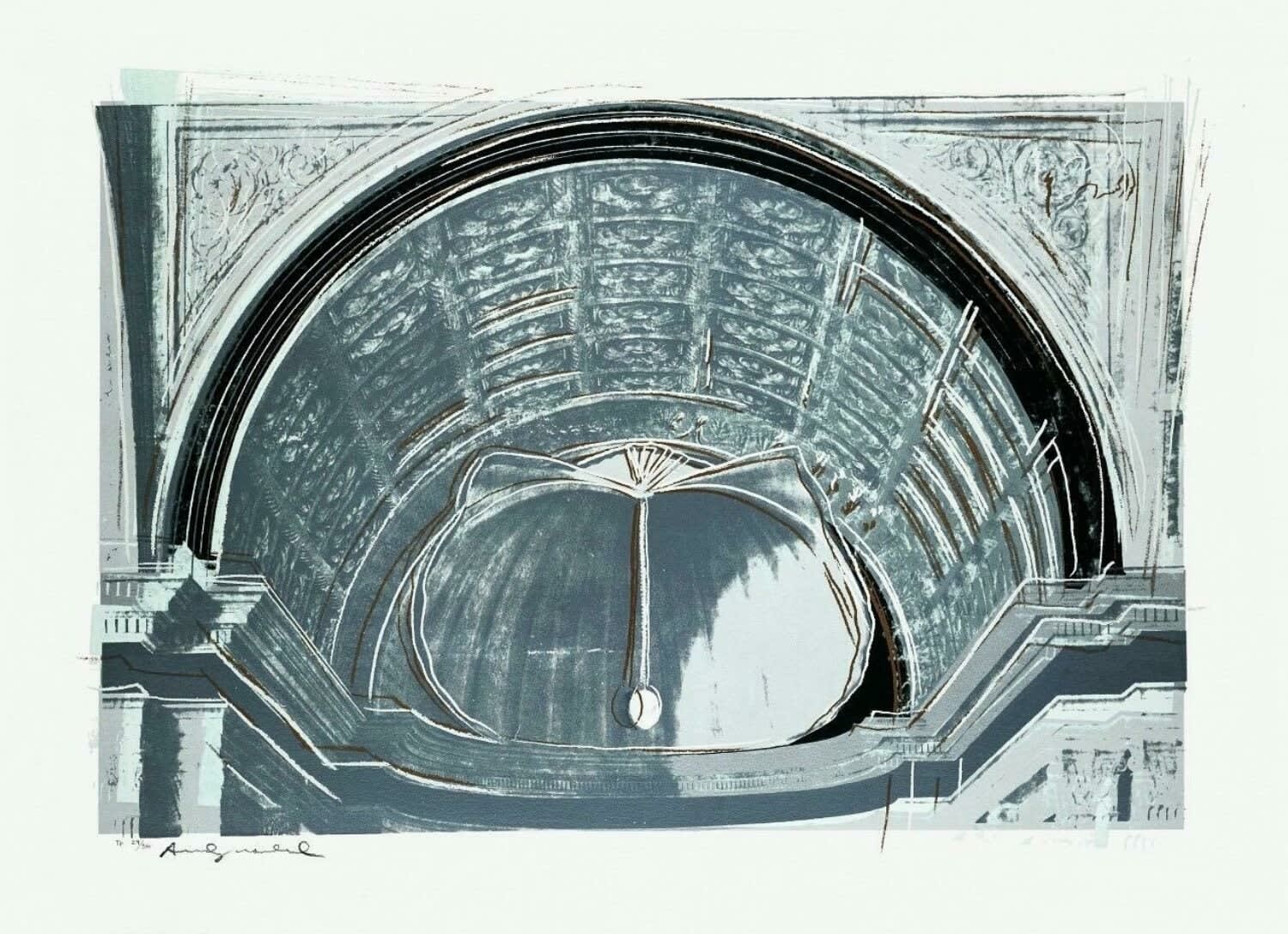
Andy Warhol
81.8 x 111.8 cm
Andy Warhol’s Madonna Del Duca (FS.II 316a), part of his Details of Renaissance Paintings series, offers a striking reinterpretation of Piero della Francesca’s Brera Madonna (also known as the Montefeltro Altarpiece). While the original Renaissance masterpiece presents a rich tableau of religious iconography—with the Virgin Mary and Child enthroned beneath a grand apse, flanked by saints, angels, and the patron Duke Federico da Montefeltro in armor—Warhol’s version strips away the narrative and human figures entirely. In doing so, he invites viewers to reconsider the painting’s architectural and symbolic elements in isolation.
Della Francesca’s altarpiece is celebrated for its serene symmetry and pioneering use of linear perspective, culminating in the apse’s domed architecture and the enigmatic ostrich egg that hangs suspended above the Madonna’s head. The egg is a loaded symbol—suggesting themes of resurrection, divine conception, and immortality—while the coffered apse evokes classical harmony and eternal order.
Warhol distills this complex visual language into a minimal, modern composition. In Madonna Del Duca, he crops the original image to highlight the apse and the ostrich egg, eliminating all figures and focusing solely on the architectural shell. This act of visual reduction transforms the Renaissance narrative into a meditation on form, color, and symbolism. Warhol accentuates the curvature of the dome and isolates the egg, imbuing these elements with renewed visual energy. His vibrant, often unexpected use of color—typical of his screenprinting technique—recasts the architectural details in a Pop Art palette, amplifying their formal qualities while stripping them of their traditional religious context.
In foregrounding the egg and the shell, Warhol engages with a rich symbolic lexicon. The egg, long associated with creation and rebirth, now floats in a suspended void, detached from its original theological frame yet retaining its metaphorical weight. The architectural shell, reminiscent of both the apse and the scallop shell associated with the Virgin Mary and Venus, draws connections to femininity, fertility, and divine beauty. These associations echo throughout Warhol’s broader Details of Renaissance Paintings series, particularly in his reinterpretation of Botticelli’s Birth of Venus, where Venus’s figure is preserved but her iconic shell is absent.
This thematic continuity across the series invites an intertextual reading. The missing clamshell in Venus finds a conceptual echo in Madonna Del Duca (FS.II 316a), where the shell is present but its symbolic inhabitants—the Madonna and Child—are not. In this way, Warhol creates a visual and conceptual dialogue within the series, one that questions what remains when religious figures are removed and only their symbolic environments are left behind. The result is a conversation not only between artist and artwork but also between Renaissance ideals and contemporary reinterpretation.
Warhol’s reimagining of della Francesca’s work is not a dismissal of the original but rather an invitation to look closer. By cropping and recoloring, Warhol reframes the historical image through the lens of 20th-century visual culture. His approach elevates the overlooked or backgrounded elements—architecture, geometry, and symbols—turning them into central subjects. This reframing aligns with Pop Art’s broader concern with repetition, reproduction, and the power of iconography.
In Madonna Del Duca (FS.II 316a), Warhol transforms a deeply sacred Renaissance painting into a modern icon. What was once a scene of divine presence becomes a study in aesthetic abstraction and symbolic potency. By doing so, Warhol does not merely reinterpret the past—he reanimates it, bridging the sacred and the secular, the historical and the contemporary. His vision challenges viewers to consider how meaning shifts when images are taken out of context, and how beauty endures even when narratives dissolve.
For more information on Andy Warhol's Details of Renaissance Paintings (Piero della Francesca, Madonna Del Duca Da Montefeltro, Circa 1472) (F.SII 316a) for sale or to buy Details of Renaissance Paintings (Piero della Francesca, Madonna Del Duca Da Montefeltro, Circa 1472) (F.SII 316a) contact our galleries using the form below.